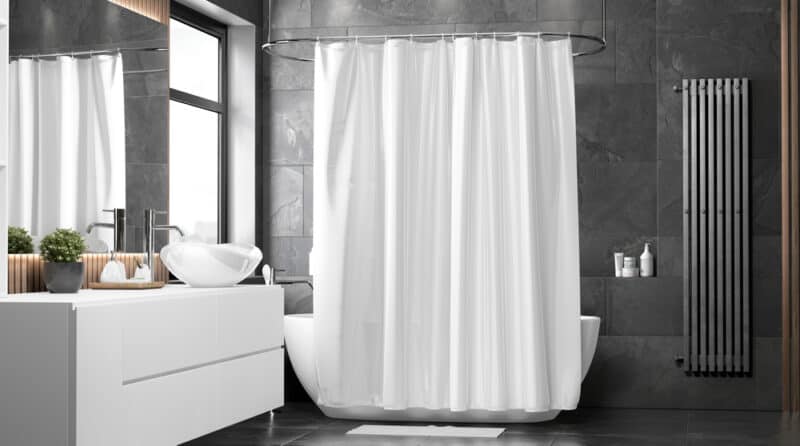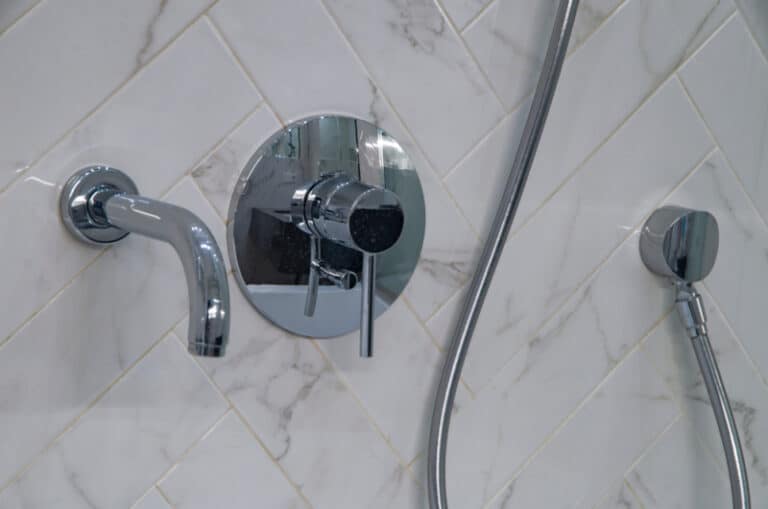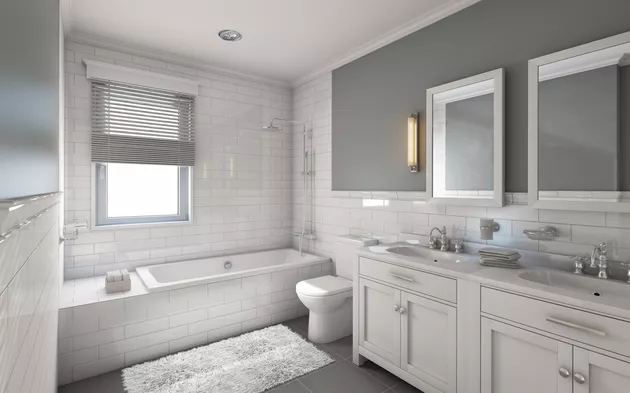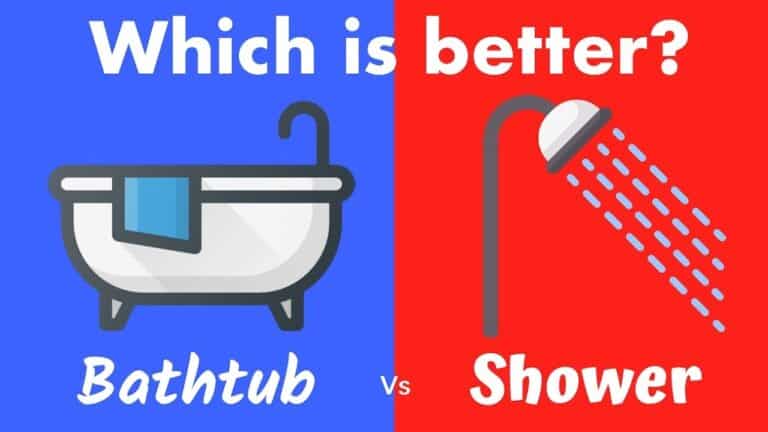How Thick Should Your Shower Curtain Be?

The purpose of the shower curtain is simply to keep the water of a shower from leaving the shower stall and entering the bathroom. A shower curtain has two portions: An outer curtain, which is typically a piece of decorative fabric, can be made from any thickness fabric, or none if you’re purchasing a piece for your own bathroom.
The outer curtain is decorative and protects people using the bathroom from seeing a scummy bathtub. The inner curtain is water-resistant and keeps the bathroom from getting soaked by the shower. If you don’t mind having a soaking wet bathroom interior, that’s one thing, but wet bathrooms grow mildew, so it’s not recommended for most people.
Inner shower curtains have different thicknesses. The thickness of the inner curtain depends on what it’s used for, and thicker inner curtains last longer than thinner ones. Conversely, a thicker inner curtain is more difficult to handle than a thinner one.
So, how thick should your shower curtain be anyway? Let’s take a look at some different liners:
Fabric Liners
Liners made of fabric have some excellent characteristics. They are more rip- and tear-resistant than thin plastic liners. Being somewhat heavier than the lightest plastic liners, they still tend to have weight pockets sewn into their hems to keep them from flying up and out under the weight of water spray.
Fabric liners are typically treated with water-resistant and bacteria-resistant chemicals like 3M Scotch-Gard. This creates a liner that is durable, stain-proof and hard to soak, but they need to be washed periodically. A fabric shower liner requires greater care than a plastic liner, which can be used for many years with only a periodic spraydown with a decalcifying cleaner like CLR. Fabric liners need to be thrown in the washing machine every so often.
Especially for home use, fabric shower curtain liners are generally preferred over plastic for all of the above characteristics. Especially because they are simply more pleasant to be in the shower with. A fabric shower liner won’t stick to skin when wet and while it has to be washed, it doesn’t end up becoming streaked with minerals over time. Properly cared for, a fabric shower liner can last for decades of daily use by a family of four to six.
PEVA/EVA shower liners are similar in look and feel to older vinyl liners. They are effective and generally easy to keep clean. PEVA liners are eco-friendly and health-friendly, without BPAs and are mildew-resistant and water-resistant. EVA shower liners typically are held up through grommets, while fabric can use grommets, snaps, and hooks.
Here’s an important video on how to measure a shower curtain:
3-Gauge Shower Curtains
3-gauge shower curtain liners are .075 millimeters thick. The thinnest shower curtains are lowest cost. 3-gauge shower curtain liners are mostly used in super-economy designs. They are highly clear so ideal if you want to use them to show off the tile work inside of your bathtub area. Because they are so thin, however, they are not recommended for use in a household with small children. A small child can easily take hold of a 3-gauge shower curtain liner and rip it off its rings or tear it in the middle of the sheet. 3-gauge liners will also typically need to be held down with integrated weights or magnets, because water pelting may cause an unweighted liner of this size to flop out of the tub, allowing water to slop onto the floor.
5-Gauge Shower Curtains
5-gauge shower curtain liners are .125 millimeters thick. These are classic middle-weight liners, which are both more affordable than heavier liners and more durable than the lighter ones. 5-gauge liners are the most common ones for home use as they are easier to manipulate, mount, and remove than heavy and super heavy gauge shower curtains. Especially in homes with pets and children, heavier curtains are more resistant to tears and rips than very thin curtains.
5-gauge curtains are more often used in homes than any other plastic type. Though they are not as comfortable to use as fabric, they’re inexpensive and typically hang straight. Especially with a magnetically weighted hem.
8-gauge shower liners
8-gauge shower liners are .20mm thick. They are among the heavier liners available. Designed for durability above all, a thick shower curtain is stiffer and harder to move around daily. For that reason, 8-gauge heavy shower liners are more often used primarily in institutional settings, where the ability to withstand damage and use.
8-gauge and thicker curtain liners being thick and heavy, they tend to be cumbersome. But like other curtain liners of PEVA and EVA plastic, they resist mildew extremely well.
10-gauge shower liners
10-gauge shower liners are very thick and heavy. Super heavy-duty designs are fabricated to cover the truly heaviest needs. Typically used in institutional and commercial settings where durability is the most important consideration. This thick shower curtain is quite stiff. This makes it harder to use and harder to manipulate than anything thinner.
Want to Install a Shower Curtain? Here’s a quick tutorial:
What Are The Best Shower Curtain Liners?
Shower curtain liners seem simple. They go on the shower rod and hang inside the shower curtain, in order to keep the water from the shower from spraying out into the bathroom.
For home use, 5-gauge PEVA is the best plastic liner. It has the best combination of characteristics between thickness, suppleness, and endurance. A good 5-gauge PEVA plastic liner will sit in the shower for years. It provides protection for the home bathroom while resisting problems that can beset fabric liners like mildew and mineral buildup.
Institutions and commercial settings, like hotels, will favor a thicker plastic liner. at least 8-gauge and sometimes 10-gauge or even 12-gauge. While these liners will be more difficult to move around, they’re highly durable and give years of service being used many times a day and sometimes even many times an hour. All without being destroyed by repeated use.
Homes wanting a touch of more traditional class and luxury will favor fabric. A fabric liner requires periodic washing in a washing machine and dryer to maintain its color and avoid becoming mildewed. It presents a more elegant appearance than any plastic liner and can be chosen in many more colors. The fabric liner is overall the best choice of shower liner for the home, though it can be difficult to use in an institutional or commercial setting.
You can also read:






